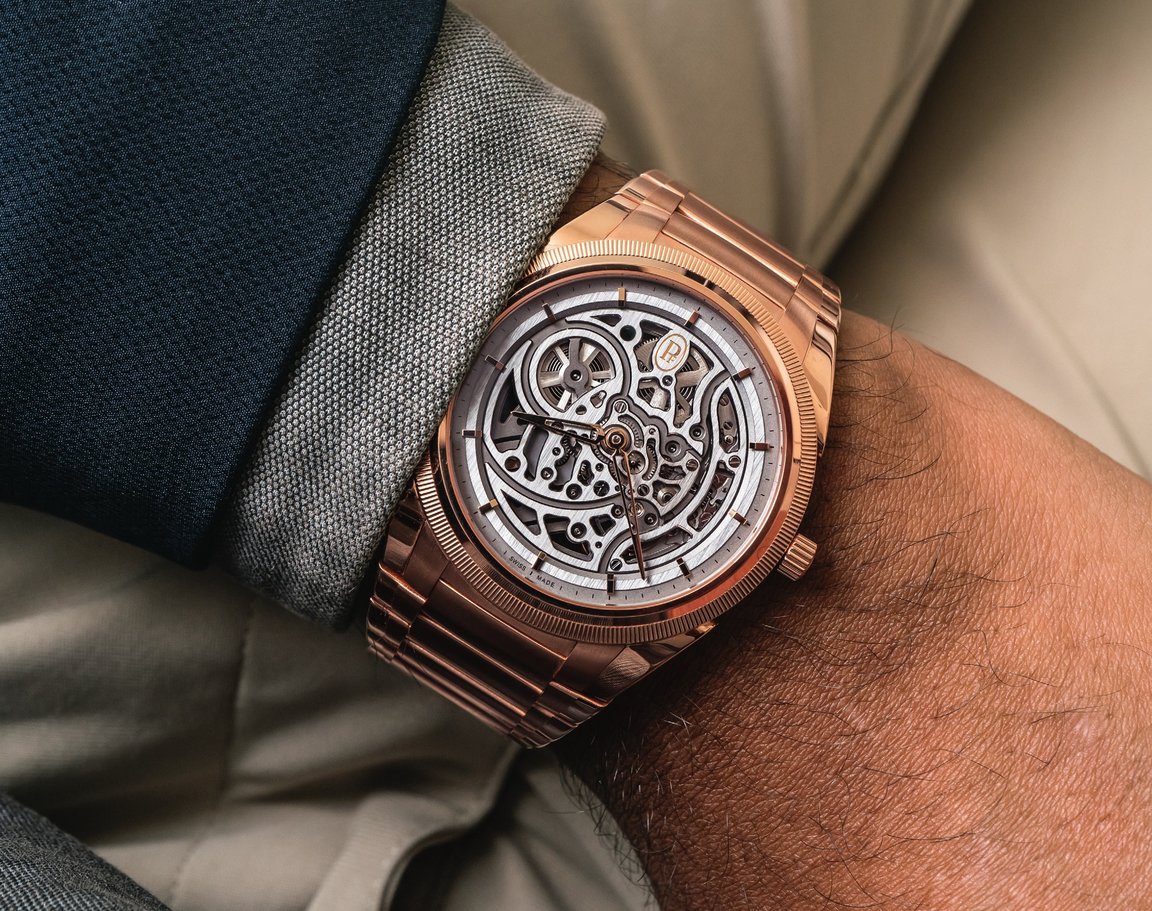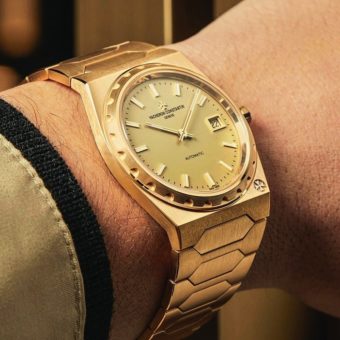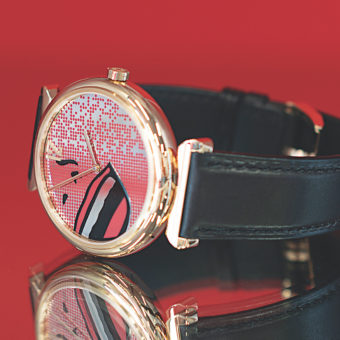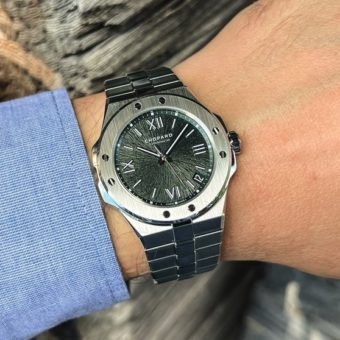This article was originally published in the September/October 2022 Issue of the WatchTime print magazine.
Under Guido Terreni, Parmigiani Fleurier has made brisk strides from a niche, slightly patrician enthusiast brand to one of the most interesting and dynamic names out there with the Tonda PF collection. Terreni had already demonstrated his talent at Bulgari with the Octo Finissimo, a collection that would cement the reputation of the brand as a major disruptor in the industry. At the helm of Parmigiani since early 2021, Terreni has quickly taken advantage of the brand’s potent vertical manufacturing capabilities, and the result is a hit.

The appeal of the Parmigiani Fleurier Tonda PF is apparent. A sports watch on bracelet with top-notch finishes, excellent in-house movements and particularly impressive attention paid to detail: In a market starved for precisely this type of product, the Tonda PF has done nothing short of transforming the brand. The collection debuted with a time-only micro-rotor model, a chronograph, an annual calendar and a split-seconds chronograph. This year at Watches & Wonders Geneva 2022, we saw the release of the second batch of Tonda PF watches. While the GMT Rattrapante deservedly got the most attention for its novel application of a split-seconds mechanism to a GMT complication, I found myself just as enamored with the pair of Tonda PF Skeleton watches.

I recently spent just shy of a week with the red-gold iteration of the Tonda PF Skeleton and walked away impressed — if not also relieved at no longer having to worry about scratching a nearly six-figure watch. Indeed, I’m impressed at how successfully the Tonda PF collection has matured in just a couple of years under Mr. Terreni’s stewardship but also at the immaculate design, execution and watchmaking on display here.
Before getting too deep into the skeletonization here, I want to briefly touch on some details that make the Tonda PF Skeleton such a cohesively designed watch. First off, the bracelet is as refined and comfortable as any other out there and I appreciate how short the links are, which makes a comfortable fit so much easier. While I’m not sure the “integrated bracelet” designation I’ve seen used is technically accurate here, the point is moot because it looks, fits and wears exactly as one would expect a luxury integrated bracelet watch to. Another detail is the matching rose-gold hand-knurled bezel, which is likely made even more potent on the steel model that has a platinum bezel.

The case proportions deserve praise as well. Automatic movements can have the unfortunate side effect of adding heft to a case but the 40-mm-wide case of the Tonda PF Skeleton comes in at just 8.5 mm thick. For me, this makes for an ideal case size for an everyday wear. Oh, and it’s water resistant to 100 meters.
Skeletonization has been seeing a steady revival in the past few years, with S-tier releases or line updates from Audemars Piguet, Vacheron Constantin and Parmigiani all largely within their integrated bracelet sports watch collections. Anecdotally, I’ve observed a noticeable uptick in appreciation for the skeletonized arts by younger enthusiasts, as well. Still, a generation of collectors (present company included) had been trained to largely dismiss skeletonization as either a musty baroque technique that flouts admittedly arbitrary standards of “minimalism” or worse, a generic “lux” add-on seemingly conceived with the sole purpose of spoiling legibility. But, these days it seems there is renewed hope.
“Wow, that’s legible!” is the G-rated edit of a refrain that I uttered at both my meeting with Parmigiani and later during my week with this watch. And the fact remains: It really is very, very legible! The sad truth is that a skeletonized dial with a set of polished gold hands would, in a vast majority of cases, be an illegible mechanical salad. Here all the curving and sweeping bridges are done with a graphite finish that lends a matte and monochromatic dial for the delta-shaped hands to contrast against. The wheels and remainder of the components are finished with rhodium plating, which matches the mellowness of the color scheme. The hand-chamfered edges of the bridges create a polish that is a nice contrast to the sandblasted and vertical brushing finishes throughout the dial.
There are thoughtful and meticulously executed little details all over this watch. Take the hour indexes, for example. While they appear fairly ordinary at first glance, a closer look shows that they are affixed to the dial only on one side at the rehaut at which point they almost cantilever over the vertically brushed ring at which point the chamfered edge lines up with the satin-brushing of the innermost ring before the dial’s skeletonized core begins. And on the caseback, note that the rotor has a sapphire crystal oval housing the PF insignia. It’s just a little touch that adds to the lightness and airiness of a skeletonized watch.

The solid gold rotor is, like the hands and indexes on the dial side, the only non-monochromatic aspect on the caseback. The automatic in-house Caliber PF777 operates at 4 Hz and has a 60-hour power reserve. No, it’s not a microrotor or manual-wind movement, which I know some people were hoping for, but in terms of practicality and execution, I have no qualms.
This is especially true when considering the measurements of the watch. Automatic movements can have the unfortunate side effect of adding heft to a case but there’s not much to complain about with an 8.5-mm-thick case. Again, I find this makes for an ideal case size for an everyday wear. Well, maybe the steel model is better as an everyday wear but the point stands.

The curving, sweeping lines of the movement embrace a decorative and relatively unusual interpretation of skeletonization that is not preoccupied with cutting off as much as possible. In the old days, skeletonization was about creating a unique canvas with which to show off exceptional finishing and decorative skills. These are gorgeous when done properly and have a strong collector community that will pay exorbitant prices for pieces like the Patek Philippe Ellipse Ref. 3880 or certain Breguet references. For most contemporary buyers, this ornate style fell out of fashion some time ago and the skeletonized options in recent years have been lackluster overall. However, it does seem like we have seen a new take on skeletonization that is gaining momentum by refocusing the technique to serve the tastes of younger buyers open to appreciating mastery of the technique in a modern style.
Still, contemporary time-only skeletonized watches have largely lent themselves to a “decorative minimalism” aesthetic that’s the inevitable result of exposing the bare bones of a relatively simple movement. Many fail at this because oftentimes the result seems arbitrary and not particularly attractive, making one question the whole purpose of the exercise in the first place.

One watch that does time-only skeletonization well is the Cartier Santos, which has its empty outer dial section framed with bridges done as Roman numerals. This way one can appreciate seeing through the “bones” and out the other side of the case while retaining the purpose of a watch as a time telling device with a cogent design behind it. And then there are the complicated skeletonized watches that do not open things up with the purpose of laying the bones bare, but rather to heighten appreciation of the inner workings. A brand that used to be known for more ornate, decorative skeletonization is Vacheron Constantin who keenly understood the changing tastes of contemporary collectors when they released the Overseas Perpetual Calendar Ultra-thin Skeleton in 2020.
There are not many examples, but some brands have seen stellar results by prioritizing legibility and crisp finishing over purely traditional interpretations of skeletonization. The Czapek Antarctique Rattrapante focused its use of skeletonization by coupling the technique with a movement that shows the split-seconds mechanism on the front of the dial. I’d also be remiss in not mentioning the Slim d’Hermès Squelette Lune that, like the Parmigiani, used darker and more muted matte finishes on the bridges and throughout. And then there’s the Audemars Piguet Royal Oak Ref. 15305. Released in 2010, the 15305 was the watch that brought skeletonization to a new generation. By opening up the Caliber 3120 and largely sticking to anthracite or gray finishes, the 15305 had a skeletonized dial that matched the industrial vibe of the Royal Oak. Adapting this oftentimes stuffy technique to match the style of the Royal Oak was a stroke of genius that has left an indelible mark on the segment.

In many ways, the Tonda PF Skeleton takes this same attitude. Proportionality and beautiful curves are central to Parmigiani’s identity and are core elements of brand founder Michel Parmigiani’s design ethos. Anyone who knows me knows how big an admirer of Parmigiani I am, both of the man and the brand. However, it wasn’t until the Tonda PF collection that everything cohesively came together by putting the Parmigiani DNA on full display but in a package the market will truly embrace. The sweeping curves of the bridges casually adhere to the Golden Ratio and the curves echo the rounded edges of the case and the recognizable teardrop lugs.
I’ll spare you the tired conversation about how popular integrated bracelet sports watches (though “leisure watches” is more apt) are these days, though it is an obvious factor in this collection’s success. For the collector who wants something a little different from the usual offerings, getting some time with the Parmigiani Tonda PF Skeleton on the wrist is well worth the effort.
To learn more about Parmigiani Fleurier, click here, and to subscribe to the WatchTime print magazine, click here.






